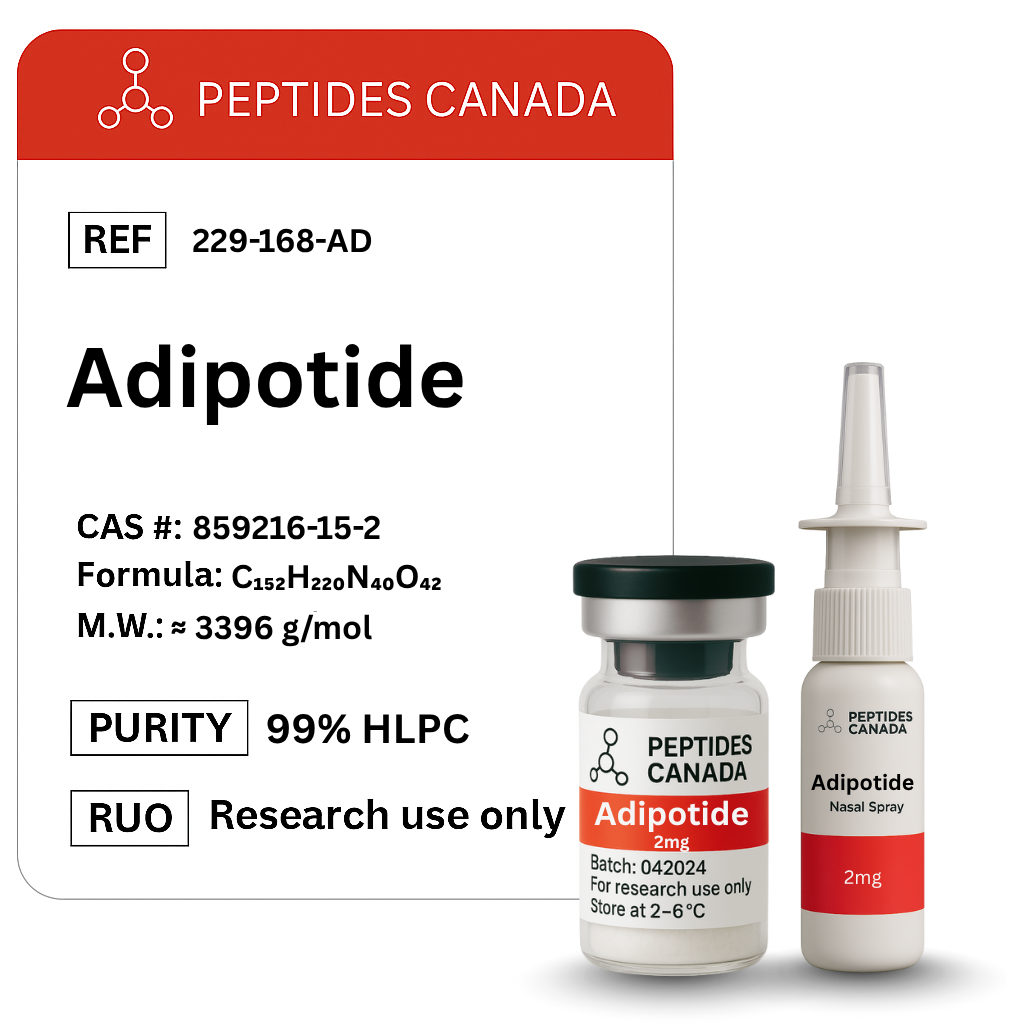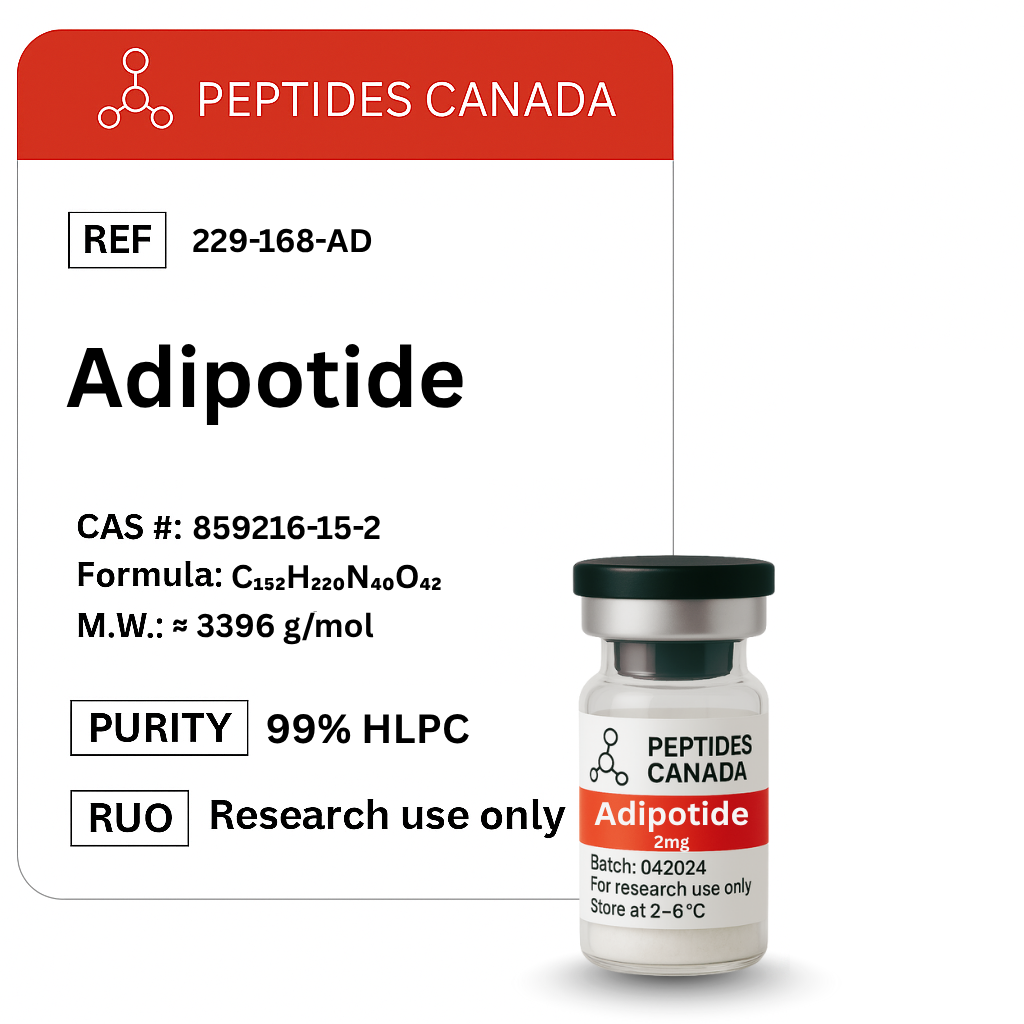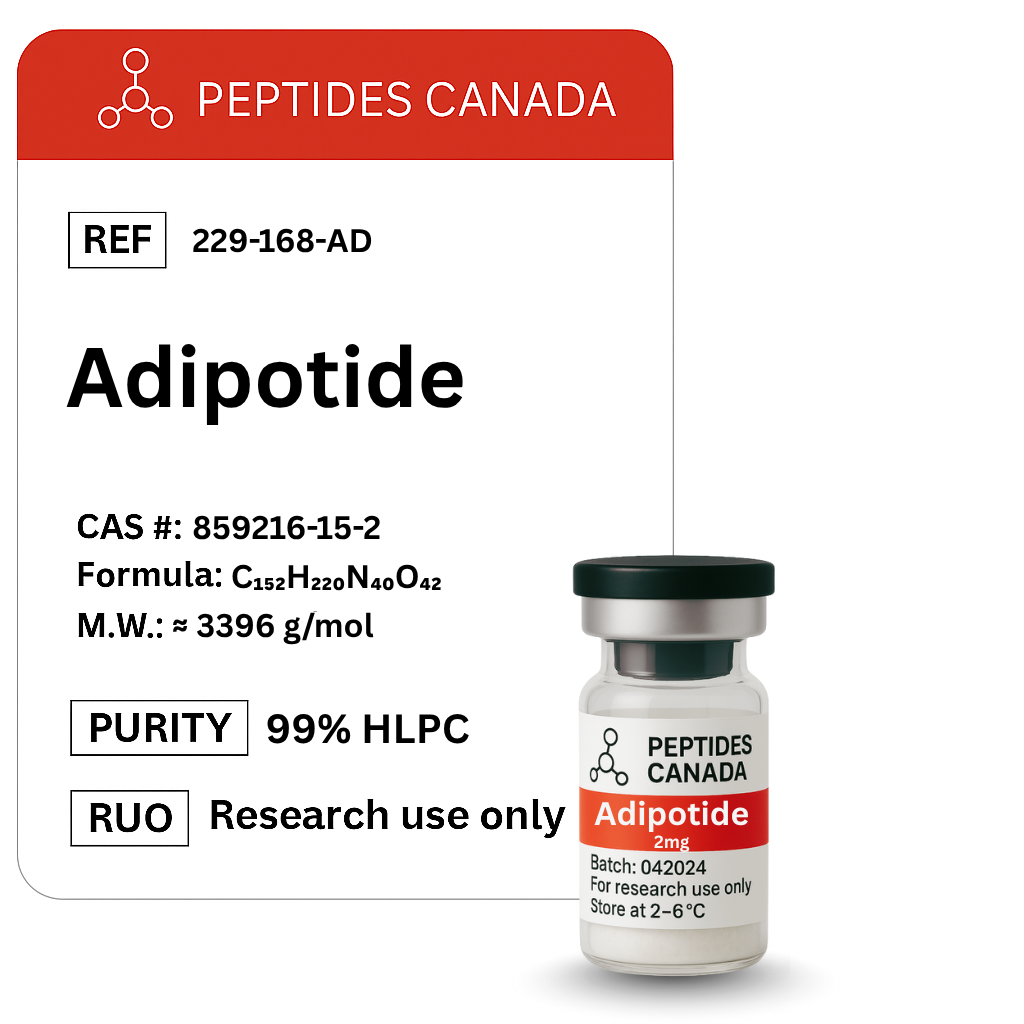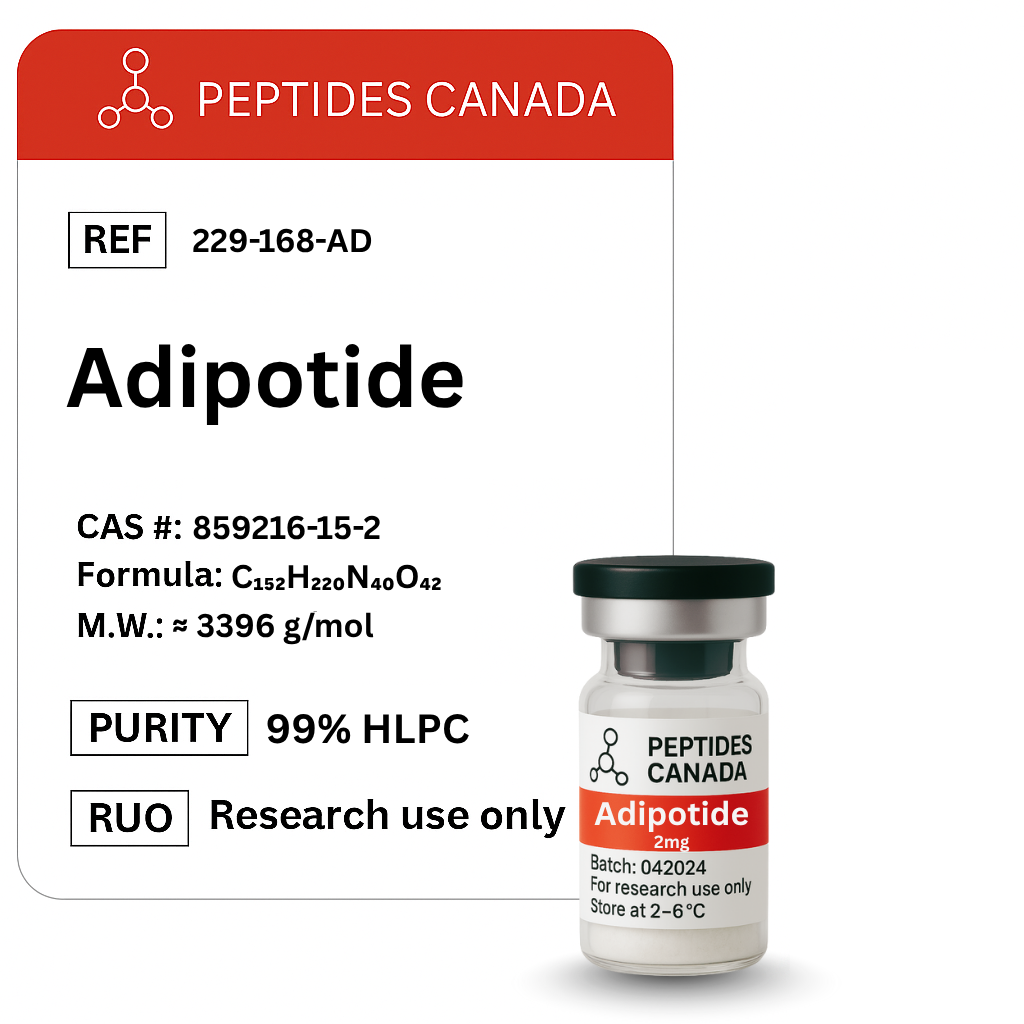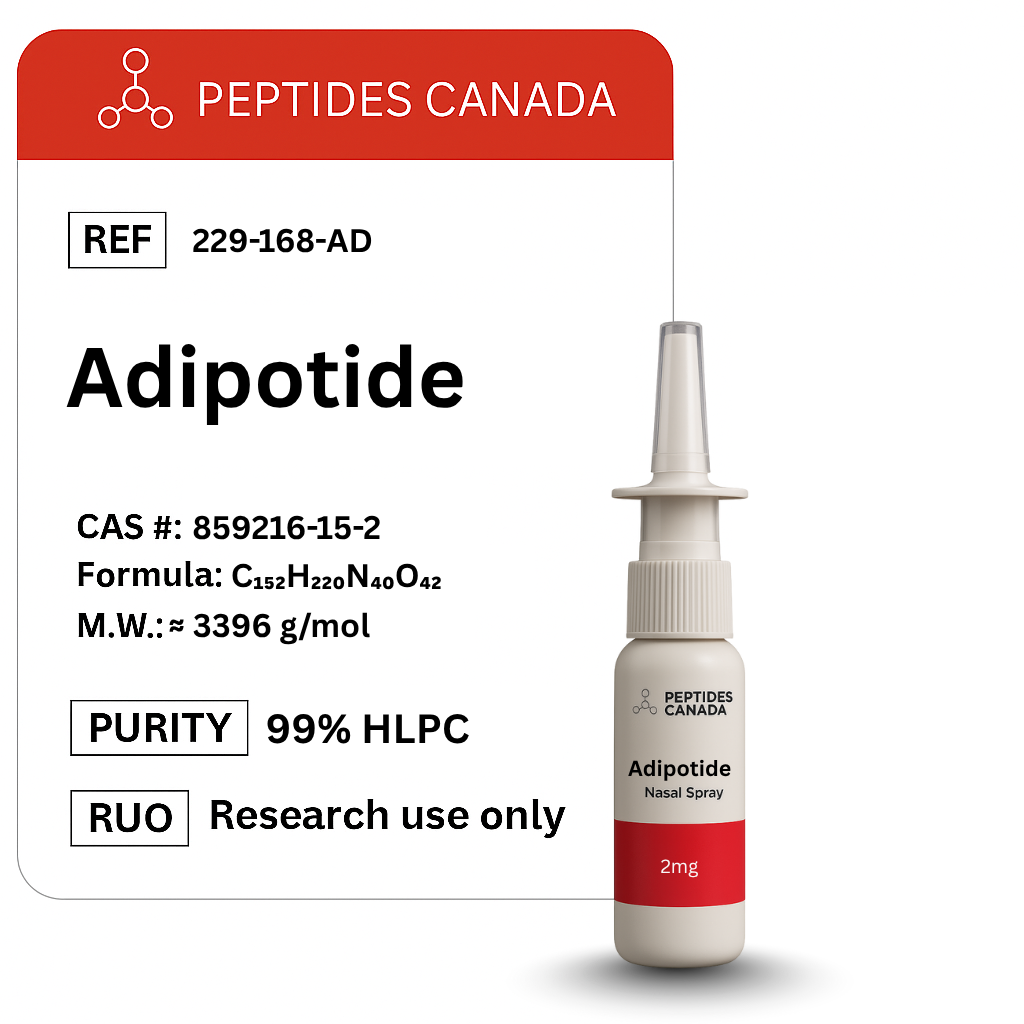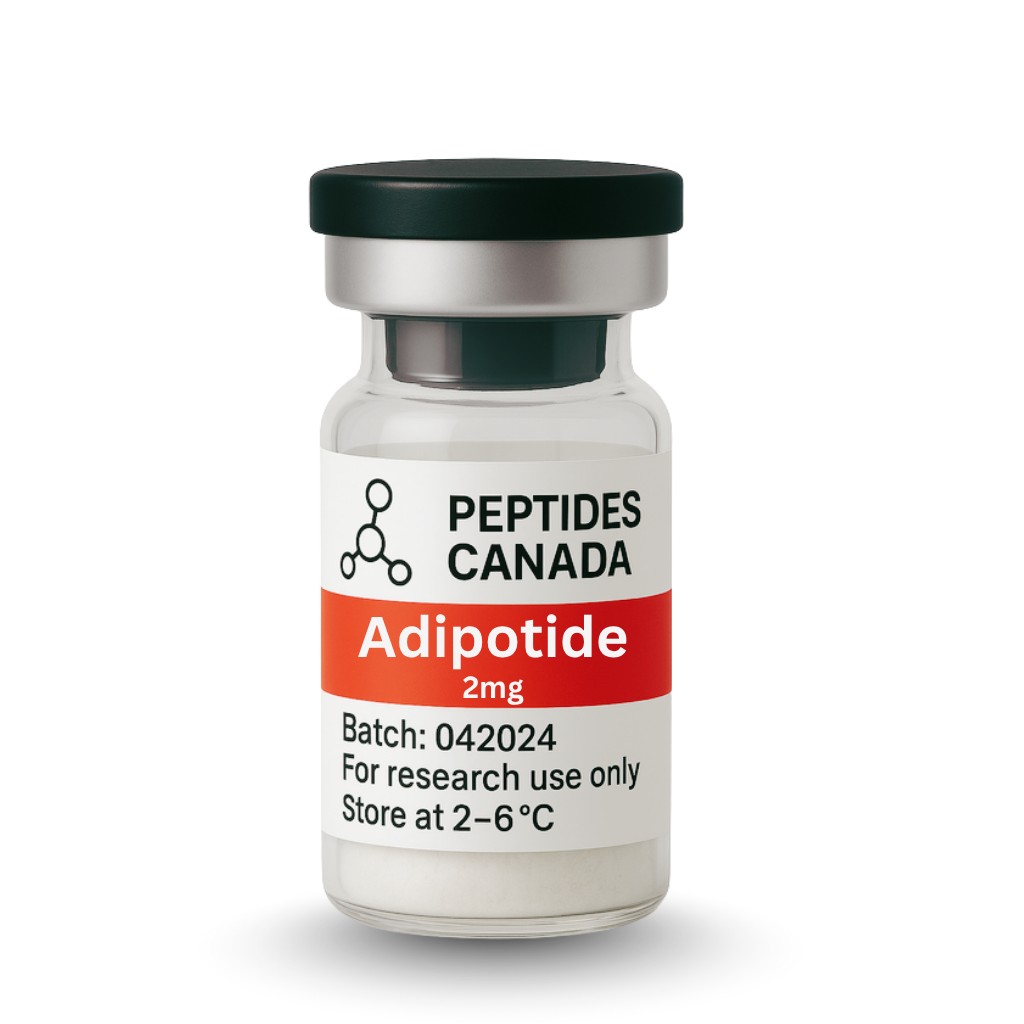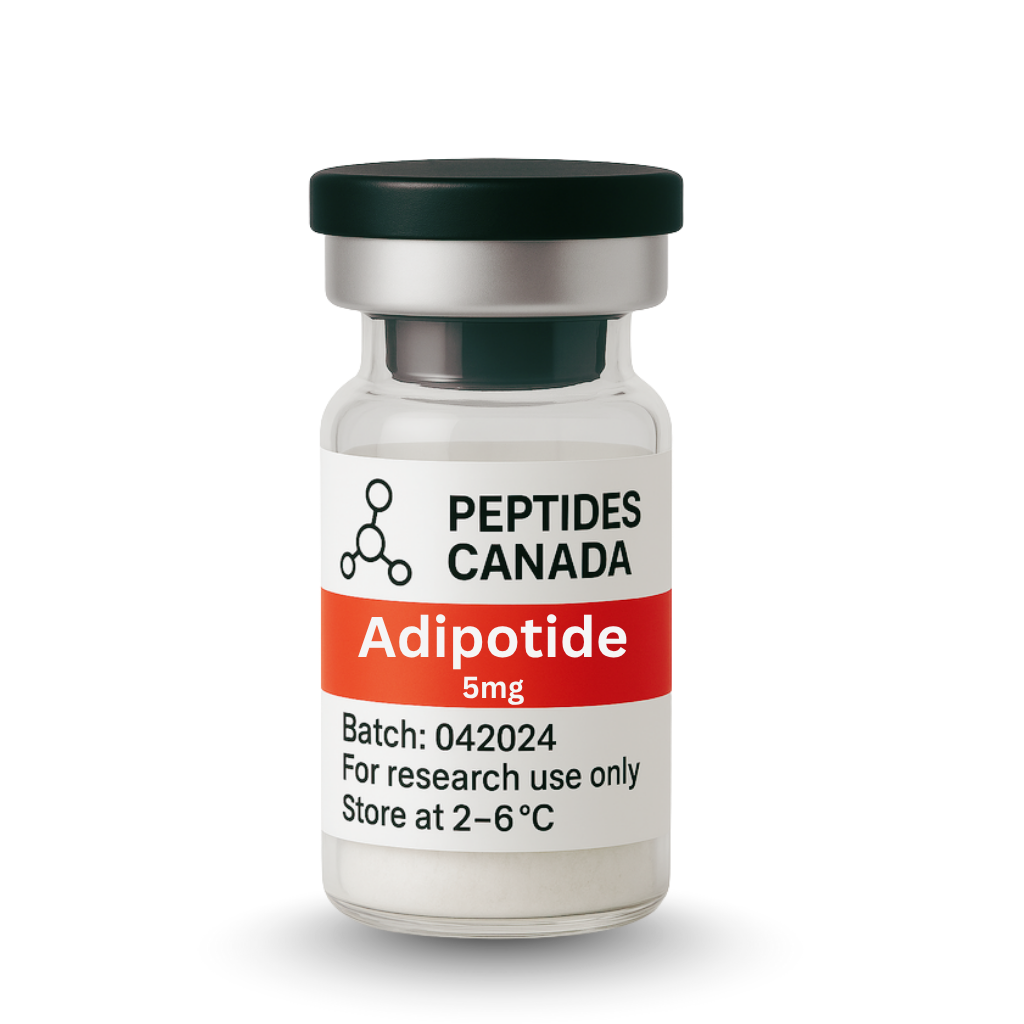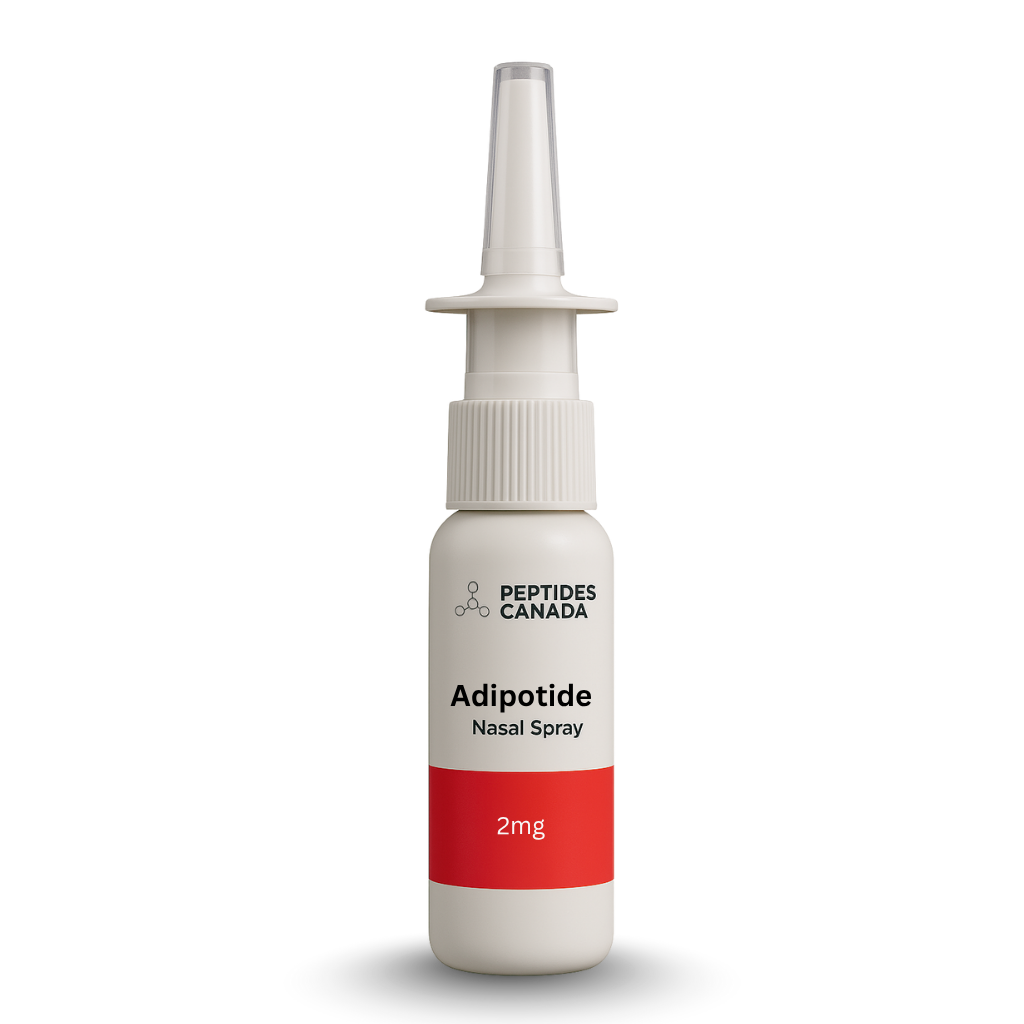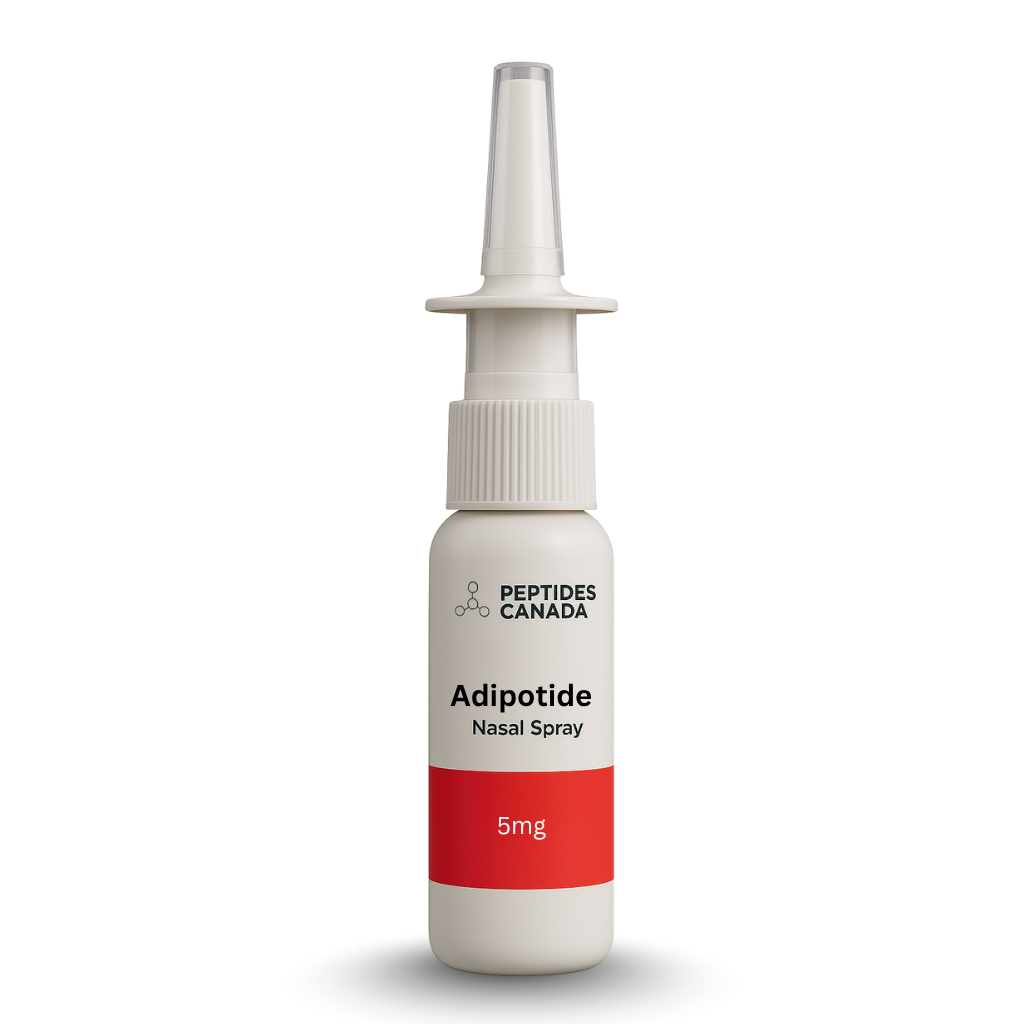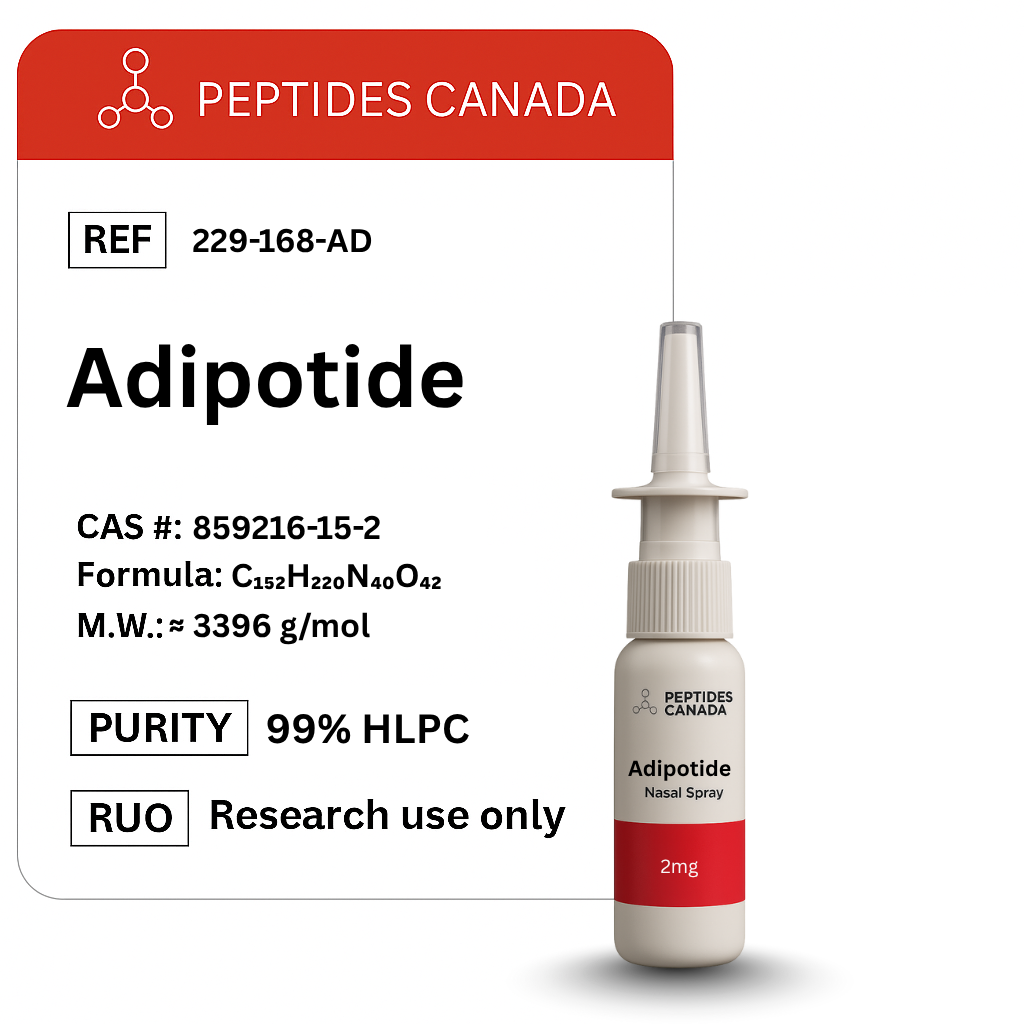Adipotide
From CAD $75 CAD $150
Contents: Adipotide (FTP-PNA, Prohibitin-Targeting Peptide)
Form: Powder
Purity: 99.3%
TESTED FOR:
- PURITY
- STERILITY
- WEIGHT
- ENDOTOXINS(LPS)
Free Reconstitution solution automatically added to your cart with each order of vial.
This product is Made, Tested & Shipped From Canada.
Ships Today
Order by 1:00 PM EST
Free Shipping
For 2 or more vials
99%+ Purity Guaranteed
COA Verified+
Trackable Shipping
Adipotide (FTP-PNA, Prohibitin-Targeting Peptide)
Adipotide, also known as FTP-PNA or CKGGRAKDC-(PEG)-KLAKLAKKLAKLAK, is a synthetic peptidomimetic compound designed to induce apoptosis of white adipose tissue vasculature. It consists of two functional domains: a targeting sequence (CKGGRAKDC) that binds to prohibitin on adipose endothelial cells, and a pro-apoptotic motif (KLAKLAK)₂ that disrupts mitochondrial membranes. Through this dual mechanism, Adipotide selectively reduces adipose tissue mass without directly affecting appetite or metabolism.
Overview
Adipotide was developed to target and eliminate the blood vessels that supply white fat depots. The prohibitin-binding motif directs the peptide specifically to the vasculature of adipose tissue, while the attached mitochondrial-disrupting sequence triggers endothelial cell apoptosis. This vascular pruning results in decreased nutrient delivery to adipocytes, followed by programmed cell death and resorption of fat stores.
Preclinical research has demonstrated that Adipotide reduces body fat, improves insulin sensitivity, and decreases fasting glucose in obese primates and rodents. It serves as a model compound for studying adipose tissue vascularization, metabolic adaptation, and targeted anti-obesity strategies.
Chemical Makeup
- Synonyms: FTP-PNA, Prohibitin-Targeted Peptide, CKGGRAKDC-KLAKLAK₂
- Molecular Formula: C₁₆₁H₂₆₈N₄₆O₃₆S₂
- Molecular Weight: ~3547.2 g/mol
- Structure: Cyclic adipose-targeting peptide linked via PEG spacer to pro-apoptotic KLAKLAK motif
- Compound Class: Synthetic peptide conjugate, adipose-vasculature targeting agent
- Purity: ≥99% (per COA)
- Form: Lyophilized powder
- Size: 5 mg and 10 mg vials available
Research and Clinical Studies
Adipose Tissue Targeting and Vascular Apoptosis
Adipotide selectively binds to prohibitin on white adipose endothelium. This triggers mitochondrial disruption, endothelial apoptosis, and subsequent adipocyte loss, resulting in measurable decreases in fat mass in treated animal models.
Obesity and Metabolic Studies
In obese rhesus monkeys, daily Adipotide administration produced significant body-weight reduction (≈11% average loss over 28 days) with concurrent improvements in insulin sensitivity and fasting glucose levels, independent of caloric intake.
Insulin Sensitivity and Glucose Regulation
Preclinical data demonstrate that Adipotide-induced adipose reduction correlates with improved glucose homeostasis and enhanced insulin responsiveness, suggesting potential use as a model for obesity-associated insulin resistance.
Mechanistic and Pathophysiological Research
Adipotide is employed to study angiogenesis, vascular remodeling, and metabolic cross-talk between adipose tissue and systemic energy balance, offering insights into adipose tissue perfusion and remodeling under energy stress.
Safety and Pharmacology
Animal studies indicate dose-dependent weight loss with reversible effects following treatment cessation. Reported findings include transient renal tubular changes at higher doses, guiding ongoing safety characterization in translational research.
Adipotide is available for research and laboratory purposes only. Not for human consumption.
References
- Kolonin MG, et al. Reversal of obesity by targeted ablation of adipose tissue. Nat Med. 2004;10(6):625–632. https://pubmed.ncbi.nlm.nih.gov/15133506/
- Barnhart KF, et al. Targeted apoptosis of adipose vasculature reduces fat mass. Nat Med. 2011;17(6):795–803. https://pubmed.ncbi.nlm.nih.gov/21602804/
- Arap W, et al. Adipose-homing peptides as targeted anti-obesity agents. Proc Natl Acad Sci U S A. 2010;107(17):7839–7844. https://pubmed.ncbi.nlm.nih.gov/20385815/
- Kolonin MG, et al. Prohibitin as a vascular target for adipose tissue. Nat Med. 2006;12(1):55–61. https://pubmed.ncbi.nlm.nih.gov/16341241/
- Daquinag AC, et al. Adipose tissue angiogenesis and remodeling in obesity. J Clin Invest. 2013;123(2):661–672. https://pubmed.ncbi.nlm.nih.gov/23321675/
- White JD, et al. Effects of adipose-targeted peptide therapy on insulin sensitivity in primates. Diabetes. 2013;62(2):474–482. https://pubmed.ncbi.nlm.nih.gov/23172932/
- Kolonin MG, et al. Selective ablation of white adipose vasculature as an anti-obesity approach. Trends Pharmacol Sci. 2012;33(8):463–471. https://pubmed.ncbi.nlm.nih.gov/22652054/
- Arap W, et al. Molecular targeting of the adipose vasculature. Biochim Biophys Acta Mol Basis Dis. 2012;1822(6):897–904. https://pubmed.ncbi.nlm.nih.gov/22285807/
- Cao Y. Angiogenesis modulation in adipose tissue: a therapeutic perspective. Circ Res. 2010;107(6):807–812. https://pubmed.ncbi.nlm.nih.gov/20814018/
- Cho CH, et al. Adipose vascular function and energy homeostasis. Endocr Rev. 2014;35(6):960–986. https://pubmed.ncbi.nlm.nih.gov/25326802/
HIGHEST QUALITY PEPTIDES
Our products are scientifically formulated and manufactured in cGMP-compliant facilities.
FAST DELIVERY
Enjoy fast and reliable 3–5 day shipping.
Dedicated Customer Service
Our customer service team is highly knowledgeable in peptide research and its applications. We’re available 24/7 to assist you.
Tested. Verified. Trusted.
We take a laboratory-first approach to quality. Each batch is made under controlled conditions and verified by an independent lab (HPLC/MS). We only ship batches that test ≥99% purity, and we provide a full COA, including identity, methods, and chromatograms, for your review.
See the Process for Yourself
We make our peptides in our own cGMP lab. Watch the video to see how every vial is produced, tested, and handled with care.
Science Behind Our Peptides
A clear explanation of how our peptides work, their benefits, why quality matters for best results, and what you should know.
Categories
Categories
How do I know the peptides I order are exactly what the label says?
Every vial we sell comes from a lab that follows current Good Manufacturing Practices (cGMP). That means each step of production is documented and controlled. Before a batch is released, it’s tested by independent third-party labs for purity, identity, and sterility. Certificates of analysis are available so you can see the exact test results.
Are your peptides produced in a sterile and controlled environment?
Yes. The labs we work with use ISO-certified clean rooms where air quality, equipment, and handling procedures are tightly regulated. Staff are trained to pharmaceutical-grade standards. This ensures the peptides are produced in an environment that minimizes contamination risks.
What about shipping? Do the peptides remain stable in transit?
Peptides in lyophilized (freeze-dried) form are stable at room temperature for transport. Once you receive them, refrigeration is recommended to maintain long-term integrity. We package every order securely to prevent damage and ship promptly, so your vials arrive in optimal condition.
How do I know you actually make these peptides yourselves?
We operate under strict in-house protocols that follow current Good Manufacturing Practices (cGMP). That means our team oversees the entire process from sourcing raw amino acids to the final lyophilized vial. Nothing is outsourced or repackaged. This gives us full control over purity, consistency, and sterility, and it’s why we can stand behind every single vial we ship.
What should I do with the vials once they arrive?
Store them in the refrigerator, away from direct light and heat. If you need to keep them longer, some peptides can be stored frozen. Each vial comes with clear handling instructions so you know the proper conditions for stability.
What proof do you have that your peptides are legitimate?
The strongest proof is transparency. For every peptide, we can provide certificates of analysis, manufacturing documentation, and references to the published scientific research behind it. If you ever have questions, we’ll show you the data rather than ask you to take our word for it.
